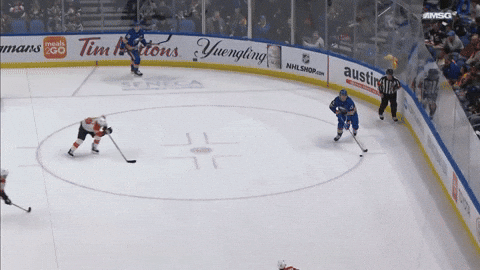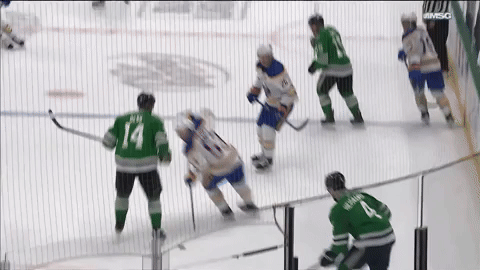
The Sabres finished 23rd in expected and actual goals per game last season. Given their hefty long-term commitments to offense-first centers (Tage Thompson, Dylan Cozens) and puck-moving blueliners (Rasmus Dahlin, Owen Power), that obviously won’t cut it.
Buffalo needs a bounce-back year on the attack, and a “lesser” name could prove the key to unlocking it in 2024-25. Health permitting, Jack Quinn appears ready to take the next step under kind-of-new head coach Lindy Ruff.
Here’s how the 2020 eighth overall selection generates offense.
Link-Up Play
Quinn is neither a burner (top speed below the 50th percentile) nor an eminently gifted puck-carrier. As such, you might not expect much from him in transition.
While it’s true that he doesn’t fit the mold of a zone entry specialist, the 22-year-old winger helps the Sabres gain access by acting as a reliable NZ intermediary. He’s well aware that the puck zips faster than he ever could, so he focuses on distributing it on time and to an available target.
A bit like Matthew Tkachuk, Quinn (BUF 22) compensates for poor mobility with an innate sense of where the chess pieces sit and where they’re headed. That processor allows him to connect the dots on his terms:
Notice how rarely the winger appears hasty in possession. He has answers for most questions presented to him. If opponents are firmly in their posture, he boasts the patience and deception to look off defenders before hitting his man. Against a more aggressive press, he’ll welcome the heat and produce sneaky flick-ons to nudge his teammates into space.
The lone concern arises when Quinn must lug the puck for an extended stretch. Not only is he a sluggish skater, but he also displays some overly cute tendencies (e.g. attempting to dance through sticks and bodies) that can get him in hot water. He doesn’t play with the sort of velocity that can excuse these risks.
Generally speaking, however, his vision, timing and touch offer the Sabres an artful link-up presence in the NZ. Speed bumps are thus easier to navigate during his shifts.
Watch how fluidly Buffalo creates a scoring chance off his puck placement:
Quinn accepts a pass on the OZ blue line with Andreas Englund (LA 5) in his grill. Opting against a direct yet likely difficult feed through the defender, he leads Casey Mittelstadt (BUF 37) into space, which serves the dual purpose of guaranteeing a safer entry and giving JJ Peterka (BUF 77) the runway to gather a head of steam.
In essence, the weight on his delivery invites the follow-up. A 3-on-4 nearly yields a Grade A opportunity as a result.
Quinn’s orchestration can spring teammates in less controlled settings too:
On a flip into the NZ, Quinn swiftly juggles a few variables:
Corralling the bouncing puck without sacrificing his speed could be tricky.
Even if he does manage to scoop it up, Jake Bean (CBJ 22) is the superior skater and will likely guide him to the boards.
Meanwhile, Peterka (BUF 77) and David Jiricek (CBG 55) are neck and neck at the red line—and the forward possesses a gear that the D-man doesn’t.
The German represents Buffalo’s highest odds of converting the clearance into a rush, so Quinn pulls Bean across the ice and taps the puck back to Peterka, introducing more pace to the proceedings. Reaching the circle ultimately buys time for Cozens (BUF 24) to emerge as a pass recipient and forces Adam Fantilli (CBJ 11) into a hooking penalty.
You’ll seldom find Quinn in Peterka’s shoes. He’s more interested in his team’s momentum than his own, and he has a habit of picking out quality north-south beneficiaries. They’re always traveling in the right direction. No surprise, then, that Buffalo’s expected goal rate tops out when he’s on the ice:
Although his skating might indicate a weak link, his nose for facilitation strengthens the ranks and thrusts them into attack mode.
OZ Spacing
In contrast to his work in the NZ, Quinn is most effective off the puck in the OZ. A prolonged touch is usually a harmless one. His impact is predicated on arriving at the telling moment to capitalize on an incisive setup or loose puck.
He delivers his finest work from mid-range:

The sample size for his SH% must be considered, of course, but Quinn has seemingly made a conscious decision to become Buffalo’s go-to lurker. A capable finisher who gets on the board through spacing and savvy instead of net-crashing or otherworldly marksmanship.
He’s developed a knack for lingering just beyond the wall of defensive sticks and just close enough to challenge goaltenders all the same.
Due to his tendency to fade and resurface, opponents can’t resist the lure of puck-watching while he’s away either. Taking your eyes off him is asking for trouble. Once you do, he slips between checks and punishes your lapse in judgment:
Quinn’s puck radar is finely tuned and all the more apparent because he’s yet to establish a scary one-timer. As it stands, he’s most dangerous as a catch-and-release weapon and clean-up man in tight. That profile depends more on sly pathing than blink-and-it’s-in shooting.
When he’s racing for the far post, his surprisingly long stride awards him dibs by a nose. When he creeps behind the rush, he lets it breathe and angles himself into space for the best possible shot. When the action settles down, he’ll lull the opposition to sleep on the fringes or behind the net before swooping onto the point of attack. He’s slowly, surely, consistently on the prowl.
Here’s an example of his work as the trailer:
As Zach Benson (BUF 9) skates off the wall and scans for options on the break, Quinn slices toward the inside hashes, which puts Cam York (PHI 8) between a rock and a hard place. You don’t want to concede a shot from the high slot, but Cozens (BUF 24) is waiting at the back door. York’s depth and Quinn’s patient route therefore provide the Sabres with a laser from prime real estate.
Slow-playing defenses comes naturally to the third-year pro. Whether it’s in transition or in scramble drills, his green-light reads are as sharp as they come in Buffalo:
After Jeff Skinner (BUF 53) wriggles into the heart of the OZ, Quinn realizes that Jamie Benn (DAL 14) has his back turned to any reinforcements. There’s your chance to tip the scales in the Sabres’ favor. He bolts in front of Dallas’ captain to outnumber the Stars 3-2 down low. Predictably, the team with more bodies in the vicinity snatches the puck.
His ability to beat defenders to the punch translated to good raw numbers (19 points in 27 games) and jaw-dropping rate stats last season:
At 5-on-5, he led his team in points per 60 minutes by a mile and ranked fifth leaguewide in that metric. Would that figure hold up over an 82-game schedule? Probably not, but on the heels of such production, the organization would love nothing more than to see a match-fit Quinn all year.
His guile and finish are particularly helpful to Cozens, a 6’3” center who can skate like the wind but sometimes loses his bearings.
Better yet, there’s untapped potential on the PP. Frequently slotted at the left point last season, he might benefit from deployment on the right side, where he can receive passes and roll downhill in search of a wrister. Another option would be plopping him at the back door—a role built on spacing and timing (two of his core attributes) rather than long-distance shooting talent.
Quinn’s performance in 2023-24 suggests he can thrive as a catch-and-release menace. Lean into that, and you’ll have the makings of a legit top-six winger.
Assuming he can stay healthy (a big question mark) and Ruff brings a measure of New Jersey’s freewheeling flair to Buffalo, the young winger is well positioned for a breakout campaign.
For a club that struggled to mount consistent offense, a coming-out party would be cause for celebration indeed.








